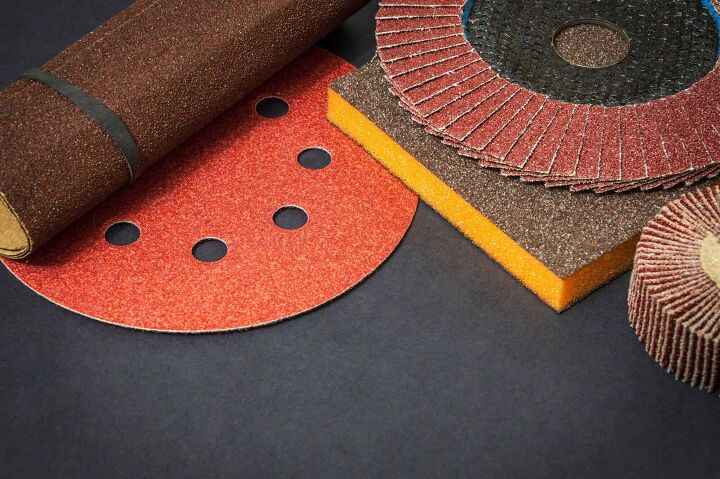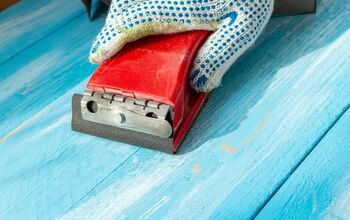What Is The Best Grit Sandpaper For Drywall?

When you’re installing drywall or just trying to improve your drywall’s appearance, chances are that you’re going to run into instructions that ask you to sand down everything. That’s great and all, but those instructions rarely ever tell you how soft or rough your sandpaper should be. Isn’t that a pain?
If only there was a way to know what the best grit of sandpaper for drywall could be…
If you’re doing drywall repair or installation, you won’t need a high-grit sandpaper to do the job. Rather, most DIYers will find that working with 80 to 150-grit sandpaper will do just fine depending on the compound layer. With that said, you might be able to go a little higher or lower depending on what you are able to do.
Though it seems like an insignificant step in your drywall repair process, the truth is that sanding makes a world of difference. You absolutely should do it right, and that includes investing in sandpaper that is the right grit for the job.
If you’re curious about how to do the best sanding job for your wallpaper, keep reading. This article is made for you.
Do You Need to Hire Drywall Installers?
Get free, zero-commitment quotes from pro contractors near you.

What Is The Best Sandpaper Grade For Drywall?
This all depends on what you’re trying to do and what stage you’re at.
If you are just starting to repair sandpaper and need to prep a surface, you should look into getting some 80 to 100-grit sandpaper to start. When you apply your first layer of compound, you will need to sand down the joint compound with coarse sandpaper.
This typically means you will need 80-grit sandpaper, since you will have lots of “nubs” to remove.
For most drywall repairs, the best grit sandpaper for finishing a job will be 150-grit sandpaper. This is considered to be “medium-grit” sandpaper, which means that it’s not overly coarse nor is it overly fine.
This gives you enough traction to smooth out issues with your compound. In some cases, you might be able to go as low as 120-grit without issue.
Should I Use A Sanding Screen?
Though you can get pretty good results with a sanding screen, the truth is that most people tend to get better results using a hand sander. Sanding screens and open mesh sanders tend to produce more dust, which means a bigger cleanup. If you can’t reach those parts of your wall, using a pole sander can also do the trick.
If I Use A Sand Screen Is The Grit Going To Be The Same?
Sanding drywall with a sand screen is not going to require the same grit as regular sandpaper. With sand screens, you will need to get finer grit. For beginning stages of drywall installations and repair, you should opt for 120-grit sand screen sandpaper. If you are going on your second round of joint compound sanding, then you will need 150-grit to 220-grit sand screen sandpaper.
What If I’m Just Doing A Typical Light Sanding Project?
If you’re not doing a multi-stage drywall repair project, the safest bet that you can take is to choose 100-grit to 120-grit sandpaper. Once you have the sandpaper, just apply a light to moderate pressure while you scrub away. Drywall is fragile and can break if you get too carried away with the sanding, you know.
Can I Use A Sander To Get Rid Of Paint On Drywall?
Getting rid of paint on a sheet of drywall isn’t going to be a job for medium-grit sandpaper. That’s because you are going to need some rough surfacing to grip the paint and remove it.
To get rid of paint on drywall, you will need to sand it down in two steps, using two different grit levels.
Step One: Stripping The Paint
With your first round of sanding, use a coarse grit sandpaper to remove the bulk of the paint. This means that you should look into having an 80-grit piece of sandpaper in most situations. Once you’ve scraped away most of the paint, you can skip to step two.
Step Two: Smoothing Out Everything
Once most of the paint has been stripped away, you should switch to a medium-grit sheet of sandpaper to even out the drywall and remove any additional paint that you might have missed. Like with other drywall projects, it’s important to be gentle here!
Drywall Sanding Tools
Unfortunately, when you’re sanding drywall, a belt or oscillating sander won’t work to your benefit. However, to achieve the best results, there are two tools you should select for use on drywall: a hand sander and a pole sander. A hand sander, which consists of a flat pad with a half-sheet of sandpaper and a handle, is the ideal choice for walls that can be accessed without the use of a ladder.
For ceilings or higher walls, opt for a pole sander. With a pole sander, the handle is replaced with a four-foot extension pole. The pad revolves around the pole, allowing to sand both narrow and wide seams with a simply back-and-forth motion.
Some professionals use a sanding sponge for finishing drywall. These tools tend to be much easier to use that a hand sander and their abrasive surface is nearly the same as 120-grit sandpaper.
Should I Use Specialty Sandpaper For My Drywall Project?
Believe it or not, there are sandpapers out there that are designed to work with specific projects. The idea behind this is that the sandpaper grit will be optimized to do the best possible job on the project it’s made for. This takes out the guesswork for many DIY projects and also might provide better results.
Though they aren’t always necessary, most DIY enthusiasts might find themselves pretty happy with the results they get from these custom-made sandpapers. If you have extra money and are open to splurging, go for it.
With that said, some of these papers are nothing more than slickly-advertised euphemisms for common sandpaper. So your mileage may vary.
Can I Use Recycled Sandpaper On Drywall?
If you have old sandpaper leftover from a past project and are looking to reuse it, you might be able to get away with it if you’re using it on drywall. You just need to make sure it’s of a similar grit to what you are in need of, and you have to make sure that it’s still in usable condition.
Some people might find it easier to attach recycled sandpaper to a sanding block for these projects, too.
Sanding Tips for Success
When you’re sanding drywall, protective gear, such as a dust mask, is crucial. You should also cover the grids in your home with plastic sheeting to avoid the dust you uplift from entering into your HVAC system.
For best results, make sure to implement proper lighting. Defects that require sanding are often very difficult to notice on unfinished drywall but will be very apparent after painting. To see the subtle depressions and ridges in the drywall, you’ll want to shine a work light either on the ceiling from behind or obliquely on the wall.
Basic overhead lighting is generally not enough for this type of project.
As you’re sanding, move the light around and vary the angle to help illuminate problem areas. Also, you can try to prevent oversanding by keeping the sander at a slight angle, pressing lightly, and avoiding scrubbing back in forth in one area.
Do You Need to Hire Drywall Installers?
Get free, zero-commitment quotes from pro contractors near you.

Related Questions
What is used to repair drywall?
Small punctures might be able to be fixed using spackle. With a medium-sized hole, you may need to use a metal patch, combined with an adhesive backing. From there, you may need to add a layer of drywall compound to make it look more even. After that, just sand the area to make it smooth.
What colors best hide wall imperfections?
Though light colors seem like they’d be the better candidates, the truth is that darker colors are better. Dark colors don’t reflect light which means that they tend to “swallow up” imperfections. Just be careful with this tip. Too many dark colors can turn a home dreary!
How long does it take to repair a hole in drywall?
This can vary greatly depending on how big the hole is as well as the method of repair you need to use. It can take anywhere from about a day’s work to upwards of three to four weeks. If you aren’t sure how long it’ll take, it’s safe to assume that bigger holes will take a longer time to fix.
Do you have to sand between coats of drywall mud?
If you were hoping to skip a step, we’re sorry to burst your bubble. You do need to sand between each coat of drywall mud. Thankfully, you don’t have to do too much sanding to make it work. You just have to get rid of any additional bumps before you get to the next step.
Can you paint directly on drywall?
Drywall has a lot of different textures that come with it. This means that primer is necessary before any drywall paint job.

Ossiana Tepfenhart is an expert writer, focusing on interior design and general home tips. Writing is her life, and it's what she does best. Her interests include art and real estate investments.
More by Ossiana Tepfenhart



























